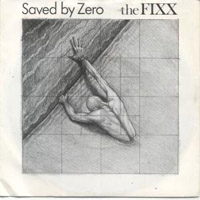Saved by Zero
| "Saved by Zero" | ||||
|---|---|---|---|---|
 |
||||
| Single by The Fixx | ||||
| from the album Reach the Beach | ||||
| B-side | "Going Overboard" | |||
| Released | April 1983 (UK); 12 May 1983 (US) | |||
| Format | 7"/12" single | |||
| Genre | New Wave, Dance-Rock | |||
| Length | 3:23 (Single Edit); 3:40 (album version) | |||
| Label | MCA | |||
| Writer(s) | Cy Curnin, Adam Woods, Jamie West-Oram, Rupert Greenall | |||
| Producer(s) | Rupert Hine | |||
| The Fixx singles chronology | ||||
|
||||
"Saved by Zero" is a song by British new wave band The Fixx. Released in 1983, it was the lead single off their second album, Reach the Beach, and is one of the group's best known hits. Their signature song is the follow-up single "One Thing Leads to Another."
An extended 4:24 version of "Saved by Zero" is included as a bonus track on the 2003 reissue of Reach the Beach. The song was featured in the fourth season of TV series Breaking Bad.
"Saved by Zero" features a repetitive, jittery guitar riff and corresponding bass. It features a soothing yet haunting presentation with its ghostly vocals and dark atmosphere. Lyrically, "Saved by Zero" is a reference to the Buddhist mantra Śūnyatā. Fixx frontman Cy Curnin reflected on its meaning in a 2008 interview:
Brian Grant had been chosen by MCA to direct the music video for "Saved by Zero." While the label had previously been financially apprehensive with The Fixx, upon the rising commercial significance of music videos, a large budget was granted for "Saved by Zero," allegedly providing "lunches, massages, and fourteen stylists." The heavy price tag, however, ultimately persuaded MCA to financially lighten up in future endeavors.
The beginning of the video pays homage to the 1941 film classic Citizen Kane by Orson Welles. The premise sees Cy Curnin playing a painter who creates the artwork for Reach the Beach. He is stranded at a flat, and he reminisces about his childhood. Another scene features Curnin painting his naked torso with white and red acrylic paint tubes.
"Saved by Zero" would become one of The Fixx's most popular songs and a concert staple. It has been described as having "acutely captured the paranoia of the Cold War in fearful lyrics."Allmusic's Stephen Thomas Erlewine named it an AMG Track Pick and called the song a "cool, robotic slice of synth pop." The song entered the charts on May 28, 1983 at #80.
...
Wikipedia
